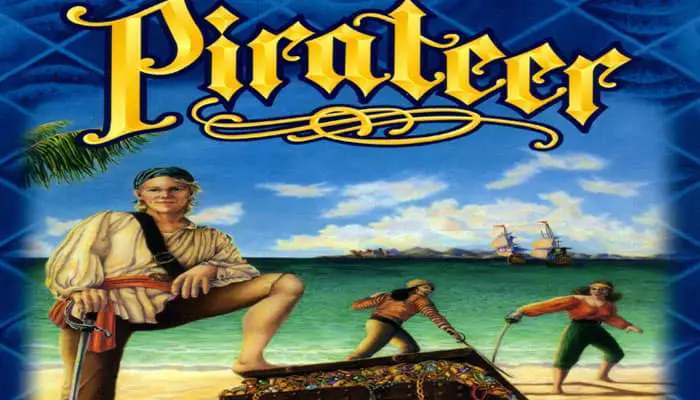
Vast treasure, fast ships and cutthroat rivals await you on the seas of Pirateer, the fast-paced strategy game where fortunes turn on pirate skullduggery and a roll of the dice.
Easy to learn, yet challenging for all ages, this award winning mix of luck, skill and treachery will entertain your family for years. Hoist the Jolly Roger and fire your imagination with Pirateer, the game of outrageous fortune.

Components
- Game board
- 12 ship markers
- Ship marker decals
- 2 dice,
- Treasure coin
- Rulebook
Setup
Each player chooses a flag and places ships on the 3 spaces next to the anchor flag at the end of their harbor.

The treasure coin is placed on Skull Island. Players then roll dice for highest total to see who plays first. Turns rotate clockwise, from right to left.

Object of the Game
The object of Pirateer is to take the treasure with one of your ships and move it to the anchor square at the end of your harbor.
 Game Board |
Game Play
Both dice must be used for movement wherever possible. If it is not possible to move with both dice, one die may be used.
Dice rolls must be flat and on the board or both dice must be rolled again. Players caught cheating must forfeit their next turn (keep a sharp eye, matie!).
Movement
Both dice are rolled for movement. Each die equals the number of spaces a ship can be moved in one direction. A roll of both dice can move a ship twice at right angles, twice in the same direction, or twice in opposite directions.
Dice rolls can also be used to move two ships in one direction each. Ships cannot move more than one direction for each die, nor can they cross other ships.
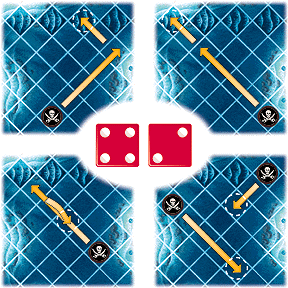
Players must use both dice to move. If movement with both dice is not possible, one die must be used. If movement is not possible, play is forfeited and the turn is passed to the next player.
Open Sea
Open sea includes all spaces except tradewinds and straits.
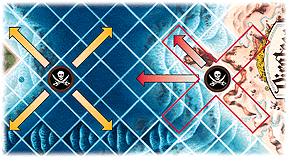
Ships can only move with the lines of the board on open sea areas. Ships cannot move diagonally on open sea or through land.
Tradewinds
The tradewinds are twenty dark, wavy squares which run the length of the board diagonally on opposite sides of Skull Island.
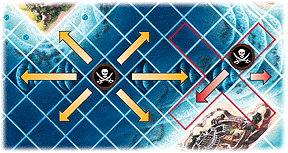
Ships can move diagonally within the tradewinds, or with the lines of the board from the tradewinds. Ships cannot move diagonally from the tradewinds, nor can they jump across the tradewinds with a move from one die.
Straits
The straits are two pairs of triangles located at the center of the long edges of the board.

Ships can move between opposite edges of the board using the straits as passages. Each strait space is 'connected' to a space on the opposite edge of the board, forming a complete square, or passage.
When a ship is on a strait space at one edge, it also occupies the strait space on the opposite edge. Ships can move with the lines of the board to and from the straits.
Ships cannot move diagonally within the straits, nor can they move diagonally to or from the straits. Ships cannot jump across the straits with a move from one die.
Treasure
Ships can take the treasure from Skull Island by landing in any of eight anchor spaces with a move from either or both dice. Taking the treasure is optional, and may be done at any time during a player's turn.
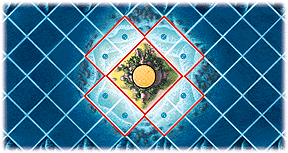
When a ship takes the treasure, its movement becomes limited. A treasure ship can move directly toward it harbor, or parallel to the length of its harbor. A treasure ship cannot move outward, or directly away from its harbor.
A treasure ship can use the tradewinds to move toward its harbor, and it can even use the straits to move parallel to the length of its harbor. A treasure ship can also capture the ships of any opponent.
Capture & Winning
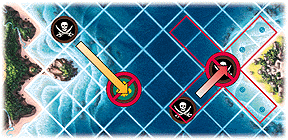
A player can capture an opponent's ship by landing on it with a move from either or both dice. Once captured, ships are removed from play for the remainder of the game. Players cannot capture ships of their own flag.
When a ship captures an opponent with the treasure, the captured ship is removed from play and the treasure is taken by the capturing ship.
End of the Game
The game ends when a player moves the treasure to the anchor square at the end of their harbor with a move from either or both dice. The game also ends when a player captures their last remaining opponent.
Continue Reading

